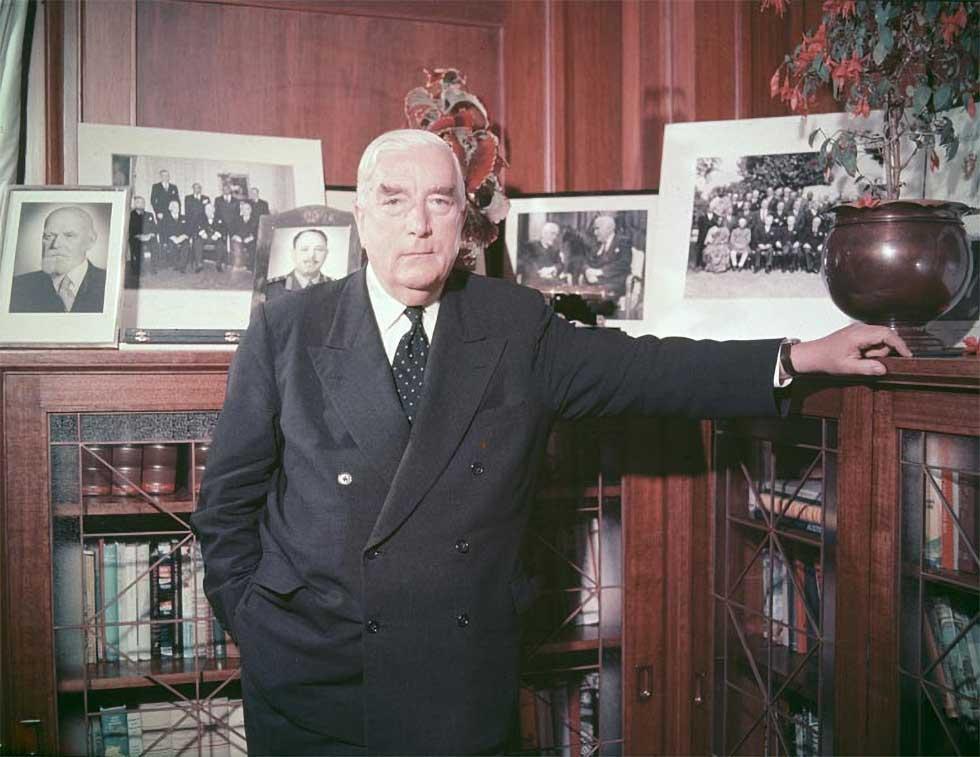


About this record
This is a colour photographic portrait showing Australian Prime Minister Robert Menzies standing in a wood-panelled room in front of a leadlight glass-fronted corner bookcase. Although unsmiling, Menzies appears relaxed, standing hand in pocket with the other arm outstretched along the top of the bookcase. Framed photographs are behind and next to him, and the Prime Minister is wearing his trademark double-breasted suit.
Educational value
- Robert 'Bob' Gordon Menzies (1894–1978), seen here about six years before he retired as the nation's longest-serving prime minister, was one of the most important figures in 20th-century Australian history. Menzies first served as Prime Minister from 1939 to 1941 in the early years of World War II. In the postwar era he regained power in 1949 and held it until he retired in 1966, leading the Liberal Party to victory in seven elections.
- Menzies' significance results not only from his longevity as Prime Minister but also from his role in founding the Liberal Party, Australia's most electorally successful federal political party. In October 1944 Menzies called a unity conference of existing non-Labor organisations and parties. The conference agreed to form a new party, to be called the Liberal Party and to be formally constituted in December 1944 with Menzies as its federal parliamentary leader.
- Menzies' long domination of Australian politics resulted from his oratorical abilities, the postwar economic boom, the Labor Party's split in 1954 (which disastrously divided the Labor vote), and his ability to exploit fears of a communist threat to Australia. Menzies held a strong demographic support base from the late 1940s until his retirement, encompassing traditional conservatives, small business owners, members of the middle class and people with middle-class aspirations.
- In 1960, the year this photograph was taken, Menzies' government introduced a 'credit squeeze' that led to his closest brush with electoral defeat. The credit squeeze, intended to deal with inflation and rising prices, raised loan interest rates and increased the sales tax on motor vehicles. It coincided with a fall in wool prices and drought. The next year the Liberal–Country Party Coalition was only narrowly re-elected with a majority of two.
- Although generally known as Sir Robert Menzies, at the time of this photograph he was plain Mr Menzies, believing that it was not appropriate for a serving prime minister to be recommended by the Governor-General for a knighthood. This changed in 1963 when Queen Elizabeth II conferred a personal knighthood on him, the Order of the Thistle. In 1965 he was appointed Constable of Dover Castle in England and Lord Warden of the Cinque Ports.
- In 1960 Menzies was well on his way to bringing about two achievements he later rated as among his greatest sources of pride – extending federal involvement in and funding of tertiary education, and developing the national capital. In the late 1950s Menzies introduced federal funding for Australia's universities, and in 1960 he insisted that money be found for the construction of Canberra's long-delayed Lake Burley Griffin, the centrepiece of its design.
- Menzies' life was one of high achievement. As a young man he had won scholarships to two private schools and then to Melbourne University where he gained a Bachelor of Laws in 1916 and a Master of Laws in 1918. He was appointed a King's Counsel in 1929. At around the same time, in 1928, he entered Victorian Parliament and in 1934 was elected to federal parliament. In 1939 he became Leader of the United Australia Party and Prime Minister for the first time.
Acknowledgments
Learning resource text © Education Services Australia Limited and the National Archives of Australia 2010.
Need help with your research?
Learn how to interpret primary sources, use our collection and more.

